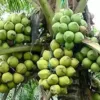₹399
The Sannangi coconut, a prized variety renowned for its exceptional taste and versatility, is a tropical delight that brings a touch of the exotic to your home or garden. With its distinctive flavor and numerous health benefits, this coconut tree is a valuable addition to any tropical landscape.
66 people are viewing this product right now
🔥 8 items sold in last 3 hours
The Sannangi coconut, a prized variety renowned for its exceptional taste and versatility, is a tropical delight that brings a touch of the exotic to your home or garden. With its distinctive flavor and numerous health benefits, this coconut tree is a valuable addition to any tropical landscape.
Sannangi coconut trees thrive in warm, tropical climates with ample sunlight and well-drained soil. Coastal regions with high humidity are particularly suitable for their growth.
Water the young coconut tree regularly, especially during dry periods. As the tree matures, it becomes more drought-tolerant.
Apply a balanced, slow-release fertilizer to the base of the tree every 3-4 months during the growing season.
Re-potting is generally not necessary for mature coconut trees. However, young seedlings may need to be repotted into larger containers as they grow.
The Sannangi coconut typically starts fruiting 5-7 years after planting. The fruiting season varies depending on the specific cultivar and climatic conditions.
Only logged in customers who have purchased this product may leave a review.

₹169
Designed, Developed & Maintained by Growww.
Copyright © 2024 Ashok Chakra Nursery
Reviews
There are no reviews yet.